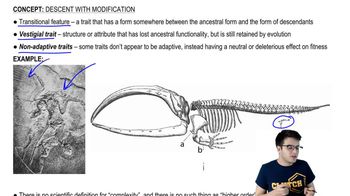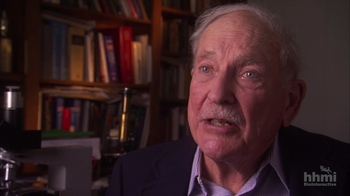Table of contents
- 1. Introduction to Biology2h 42m
- 2. Chemistry3h 40m
- 3. Water1h 26m
- 4. Biomolecules2h 23m
- 5. Cell Components2h 26m
- 6. The Membrane2h 31m
- 7. Energy and Metabolism2h 0m
- 8. Respiration2h 40m
- 9. Photosynthesis2h 49m
- 10. Cell Signaling59m
- 11. Cell Division2h 47m
- 12. Meiosis2h 0m
- 13. Mendelian Genetics4h 44m
- Introduction to Mendel's Experiments7m
- Genotype vs. Phenotype17m
- Punnett Squares13m
- Mendel's Experiments26m
- Mendel's Laws18m
- Monohybrid Crosses19m
- Test Crosses14m
- Dihybrid Crosses20m
- Punnett Square Probability26m
- Incomplete Dominance vs. Codominance20m
- Epistasis7m
- Non-Mendelian Genetics12m
- Pedigrees6m
- Autosomal Inheritance21m
- Sex-Linked Inheritance43m
- X-Inactivation9m
- 14. DNA Synthesis2h 27m
- 15. Gene Expression3h 20m
- 16. Regulation of Expression3h 31m
- Introduction to Regulation of Gene Expression13m
- Prokaryotic Gene Regulation via Operons27m
- The Lac Operon21m
- Glucose's Impact on Lac Operon25m
- The Trp Operon20m
- Review of the Lac Operon & Trp Operon11m
- Introduction to Eukaryotic Gene Regulation9m
- Eukaryotic Chromatin Modifications16m
- Eukaryotic Transcriptional Control22m
- Eukaryotic Post-Transcriptional Regulation28m
- Eukaryotic Post-Translational Regulation13m
- 17. Viruses37m
- 18. Biotechnology2h 58m
- 19. Genomics17m
- 20. Development1h 5m
- 21. Evolution3h 1m
- 22. Evolution of Populations3h 52m
- 23. Speciation1h 37m
- 24. History of Life on Earth2h 6m
- 25. Phylogeny2h 31m
- 26. Prokaryotes4h 59m
- 27. Protists1h 12m
- 28. Plants1h 22m
- 29. Fungi36m
- 30. Overview of Animals34m
- 31. Invertebrates1h 2m
- 32. Vertebrates50m
- 33. Plant Anatomy1h 3m
- 34. Vascular Plant Transport1h 2m
- 35. Soil37m
- 36. Plant Reproduction47m
- 37. Plant Sensation and Response1h 9m
- 38. Animal Form and Function1h 19m
- 39. Digestive System1h 10m
- 40. Circulatory System1h 57m
- 41. Immune System1h 12m
- 42. Osmoregulation and Excretion50m
- 43. Endocrine System1h 4m
- 44. Animal Reproduction1h 2m
- 45. Nervous System1h 55m
- 46. Sensory Systems46m
- 47. Muscle Systems23m
- 48. Ecology3h 11m
- Introduction to Ecology20m
- Biogeography14m
- Earth's Climate Patterns50m
- Introduction to Terrestrial Biomes10m
- Terrestrial Biomes: Near Equator13m
- Terrestrial Biomes: Temperate Regions10m
- Terrestrial Biomes: Northern Regions15m
- Introduction to Aquatic Biomes27m
- Freshwater Aquatic Biomes14m
- Marine Aquatic Biomes13m
- 49. Animal Behavior28m
- 50. Population Ecology3h 41m
- Introduction to Population Ecology28m
- Population Sampling Methods23m
- Life History12m
- Population Demography17m
- Factors Limiting Population Growth14m
- Introduction to Population Growth Models22m
- Linear Population Growth6m
- Exponential Population Growth29m
- Logistic Population Growth32m
- r/K Selection10m
- The Human Population22m
- 51. Community Ecology2h 46m
- Introduction to Community Ecology2m
- Introduction to Community Interactions9m
- Community Interactions: Competition (-/-)38m
- Community Interactions: Exploitation (+/-)23m
- Community Interactions: Mutualism (+/+) & Commensalism (+/0)9m
- Community Structure35m
- Community Dynamics26m
- Geographic Impact on Communities21m
- 52. Ecosystems2h 36m
- 53. Conservation Biology24m
21. Evolution
Introduction to Evolution and Natural Selection
Problem 6`
Textbook Question
Some biologists summarize evolution by natural selection with the phrase "mutation proposes, selection disposes." Mutation is a process that creates heritable variation. Explain what the phrase means.
 Verified step by step guidance
Verified step by step guidance1
Understand the role of mutation in evolution: Mutation is a random change in the DNA sequence of an organism. These changes can introduce new genetic variations within a population, which are heritable and can be passed on to future generations.
Recognize the significance of genetic variation: Genetic variation is crucial for evolution because it provides the raw material for natural selection to act upon. Without variation, there would be no differences in traits for natural selection to favor or disfavor.
Explore the concept of natural selection: Natural selection is the process by which certain traits become more common in a population because they confer a survival or reproductive advantage. Organisms with advantageous traits are more likely to survive and reproduce, passing those traits to their offspring.
Interpret the phrase 'mutation proposes, selection disposes': This phrase suggests that mutations introduce new genetic possibilities ('proposes'), while natural selection determines which of these possibilities are beneficial and should be retained in the population ('disposes').
Connect mutation and selection in the context of evolution: Together, mutation and natural selection drive the evolutionary process. Mutations generate diversity, and natural selection filters this diversity, leading to adaptation and the evolution of species over time.
 Verified video answer for a similar problem:
Verified video answer for a similar problem:This video solution was recommended by our tutors as helpful for the problem above
Video duration:
3mPlay a video:
Was this helpful?
Key Concepts
Here are the essential concepts you must grasp in order to answer the question correctly.
Mutation
Mutation refers to changes in the DNA sequence of an organism's genome. These changes can be caused by errors during DNA replication or external factors like radiation. Mutations introduce genetic variation, which is essential for evolution, as they provide new traits that may be beneficial, neutral, or harmful to the organism.
Recommended video:
Guided course

Mutations
Natural Selection
Natural selection is the process by which certain traits become more common in a population because they confer a survival or reproductive advantage. Organisms with advantageous traits are more likely to survive and reproduce, passing these traits to the next generation. Over time, this leads to the adaptation of species to their environments.
Recommended video:

Natural Selection
Heritable Variation
Heritable variation refers to genetic differences that can be passed from parents to offspring. This variation is crucial for evolution, as it provides the raw material for natural selection to act upon. Without heritable variation, populations would lack the diversity needed to adapt to changing environments or new challenges.
Recommended video:

Sources of Genetic Variation

 4:58m
4:58mWatch next
Master Evolution and Natural Selection with a bite sized video explanation from Jason
Start learningRelated Videos
Related Practice
































